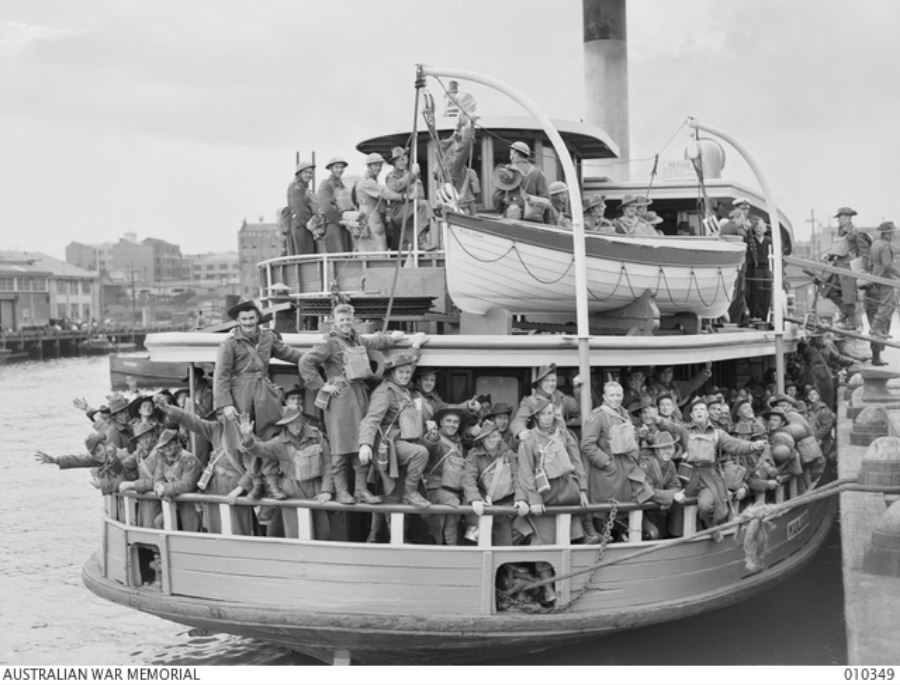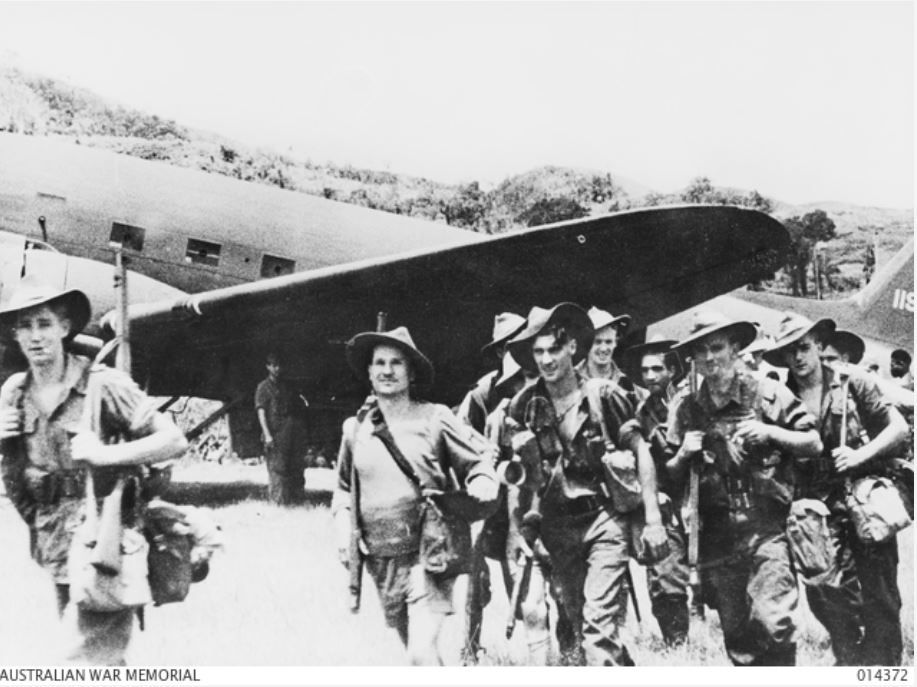2/5th Australian Infantry Battalion
From Our Contribution
 1 Nov 1941. Ferry load of reinforcements for 2/5th and other units AWM photo 010349 | |
 2/5th Bn flown in for the advance on Wau. AWM photo 014372 | |
Contents
[hide]Brief History
The 2/5th Australian Infantry Battalion was formed at the Royal Melbourne Showgrounds, Melbourne during October 1939, as part of the 17th Australian Infantry Brigade of the 6th Australian Infantry Division. Its first drafts of recruits were not received until after it had moved to Puckapunyal on 2 Nov 1939. Basic training was undertaken prior to the battalion's departure for overseas service on 14 Apr 1940.
After arriving in the Middle East on 18 May 1940, the battalion undertook further training in Palestine and Egypt. The 2/5th took part in the advance against the Italians in Cyrenaica during January and February 1941, participating in successful attacks at Bardia (3-5 January) and Tobruk (21-22 January). In early April, the 2/5th, with the rest of the 6th Division, deployed to Greece to resist the anticipated German invasion. For the 2/5th, the Greek campaign was essentially one long withdrawal from its initial defensive positions at Kalabaka (occupied on 14 April) to the port of Kalamata, from where it was evacuated on 27 April. Some 50 transport drivers were left behind in Greece and became prisoners. A similar sized group landed on Crete and, after fighting with the 17th Brigade Composite Battalion, also suffered the same fate.
Back in Palestine, the remainder of the 2/5th Battalion was given little respite. In June and July 1941, it took part in the Syrian campaign, including the key battle of Damour (6-10 July) that sealed the defeat of the Vichy French forces. The battalion then remained in Syria and Lebanon as part of the garrison force until January 1942. It left the Middle East, heading for the war against Japan, on 10 March 1942. However along with other 16th and 17th Brigade units, it was diverted on the voyage home, and from early March to early July they defended Ceylon (Sri Lanka) from possible Japanese attack. The 2/5th Battalion finally disembarked in Melbourne, on 4 Aug 1942.
The 2/5th deployed to Milne Bay, in Papua, in early October 1942 but did not meet the Japanese in battle until the end of January 1943, when it joined the force defending Wau, in New Guinea. After much desperate fighting, the Japanese around Wau were defeated in early February. The 2/5th subsequently participated in the drive towards Salamaua and was heavily engaged around Goodview and Mount Tambu in July and August. After arriving back in Australia at Cairns on 23 September 1943 for a rest, the 2/5th spent most of 1944 training in northern Queensland.
On 29 November 1944, the 2/5th disembarked at Aitape in New Guinea for its last campaign of the war. It spent much of the next seven months engaged mainly in arduous patrolling to clear the Japanese from the Torricelli and Prince Alexander mountain ranges. It was still engaged in this role when the war ended on 15 August 1945. The battalion embarked to return to Australia on 1 December and disbanded at Puckapunyal in early February 1946. It was one of only two battalions that fought all of Australia's major enemies during the Second World War.
Battalion Personnel
- Alan Henry Brockwell 21 Sep 1944 - 21 Nov 1945
Battle Honours
- North Africa
- Bardia 1941
- Capture of Tobruk
- Greece 1941
- Syria 1941
- Merjayun
- Damour
- South-West Pacific 1942-1945
- Wau
- Bobdubi II
- Mubo II
- Mount Tambu
- Komiatum
- Liberation of Australian New Guinea
- Perimbil
- Balif
- Yamil-Ulupu
- Kaboibus-Kiarivu
Individual Honours
- 1 x Member of the Order of the British Empire
- 1 x Distinguished Service Order
- 1 x Bar to the Distinguished Service Order
- 11 x Military Cross
- 1 x Bar to Military Cross
- 6 x Distinguished Service Medal
- 20 x Military Medal
- 59 x Mentioned in Despatches
- 1 x United States Silver Star
Notes
Information has come from the Australian War Memorial website [1] accessed 6 Feb 2021.